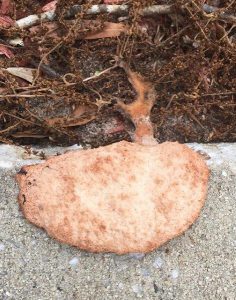With most of us being at home more due to restrictions on getting out, people seem to be noticing more of what is going on in their own lawns, landscapes and gardens. As a result, I am getting more questions about “unusual” things being seen. One of which happens to be slime mold.
Slime molds are common and appear suddenly during warm, wet weather. Most people become alarmed and automatically assume that they are seeing something that is doing harm to their lawns or landscapes. However, slime molds are rarely harmful to plants.

One of the more common slime molds found in lawns looks like soot on the grass blades. What you are seeing is the spore mass when this “mold” goes into a reproductive state. This white, gray or darker spore mass will cover the leaves but it is only on the surface of the grass blades. It is not functioning as a pathogen (not entering and infecting plant tissue). It is just a cosmetic issue. As a matter of fact, it can be rubbed off or washed off revealing healthy green grass blades underneath the soot-like spore mass.
This particular slime mold requires no chemical control. It is not a plant disease. It will go away on its own usually within days of appearing. It may appear to move around the yard as different sections go into a reproductive stage.
The best advice is to let it “run its course” and continue correct lawn watering, mowing and fertilization practices. In areas where it really bothers you, remove the slime mold by mowing or washing it off with a strong stream of water. Excessive thatch accumulation also increases the probability of slime mold occurrence.
There are many different slime molds. Some look like alien blobs growing on and over thinning areas of the lawn, mulch in plant beds or on top of compost.
The slime molds are not fungi but are classified as plasmodia or Protista. The different types are referred to as myxomycetes or dictyosteliomycetes. They are more closely related to amoebas and certain seaweeds than fungi.
Slime molds are varied, interesting and misunderstood. Some have descriptive names such as scrambled egg

slime, dog vomit slime mold and wolf’s milk.
Here are a two links with more information on slime molds. The one from Rutgers Extension includes a link to some very interesting time-lapse videos.
https://plant-pest-advisory.rutgers.edu/11118
https://wimastergardener.org/article/dog-vomit-slime-mold-fuligo-septica
 0
0
